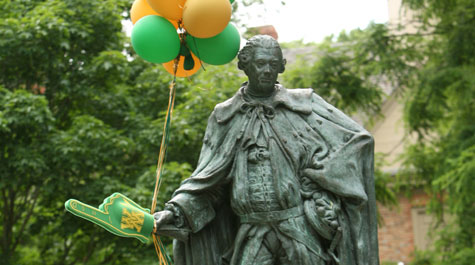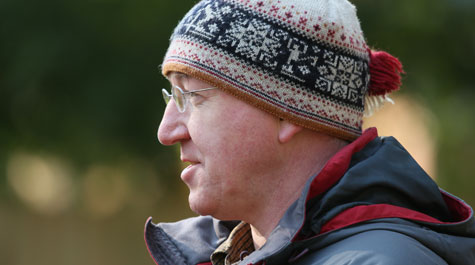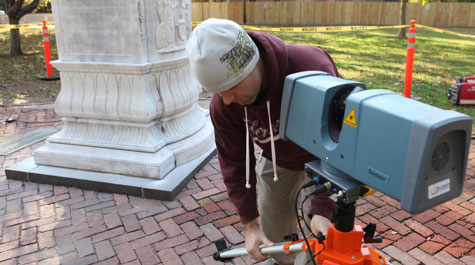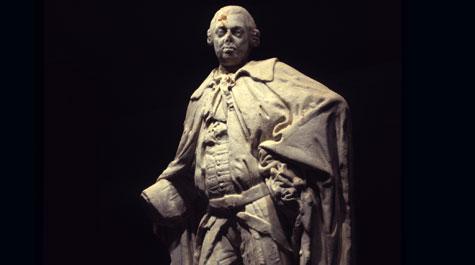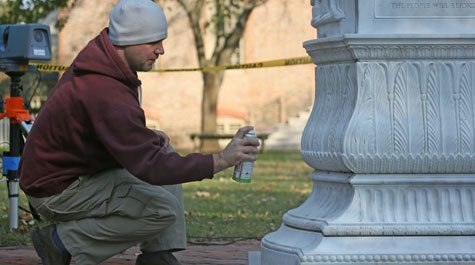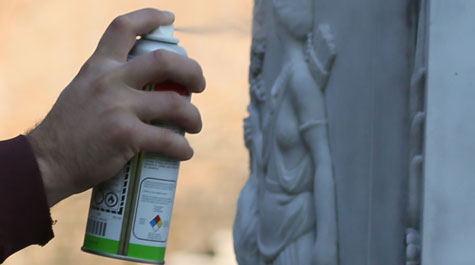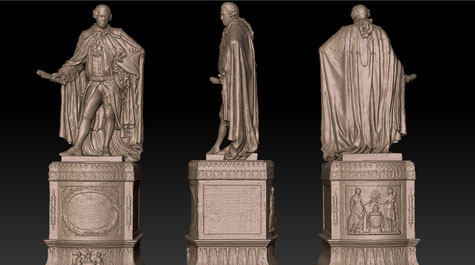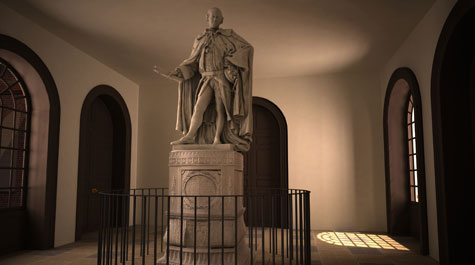Virtual Williamsburg project sees Lord B in 3-D
A statue of Lord Botetourt, one of the College’s early Rectors, sits at the center of the College Yard and the heart of William & Mary’s Historic Campus. It lends a stately air to the east vista of the university's Sir Christopher Wren Building. It looks so good, in fact, onlookers may think the statue has stood there since the College's founding in 1693. But William & Mary isn’t the statue’s first home, and a team of researchers from the Colonial Williamsburg Foundation are working on a project to put the statue back in its original location, even if just virtually.
The project, Virtual Williamsburg, is creating an interactive 3-D model of Williamsburg in 1776.
“This is a multi-phase project. In this first phase, the digital recreation will focus on the east end of town, including the Capitol and more than 30 other buildings” said Peter Inker, digital architectural historian, Colonial Williamsburg’s Digital History Center.
The 1776 Capitol building, Williamsburg’s second – the first having been destroyed by fire - was the original home of the Botetourt statue. The statue was placed in the Capitol’s Loggia in 1773 in honor of Norborne Berkeley, 4th Baron of Botetourt, who had served as governor of the Virginia Colony from 1768 until his death in 1770 (he served as Rector of the university during the same period).
“We are trying to be as accurate as possible and so have reappraised all of the research that has taken place since Colonial Williamsburg was founded. The Capitol in today’s Williamsburg is a reconstruction of the first Capitol. We are virtually reconstructing the second Capitol to 1776, and so this will be people’s first opportunity to experience the Revolutionary Capitol,” Inker noted.
The Botetourt statue is a key element of the later Capitol. When the project is complete, a full 3-D replica of the statue will sit at the heart of the Capitol’s Loggia. To make this happen, Inker and his crew were on campus in November using a laser to scan the structure. The process took the better part of a day and included head to base scans from more than a dozen different vantage points.
“Having this statue will be the icing on the cake,” said Edward Triplett with the Institute for Advanced Technologies in the Humanities (IATH) at the University of Virginia, a partner in the Virtual Williamsburg project.
“Marble is a challenge,” said Glenn Woodburn, lead digital modeler for Direct Dimensions, Inc. (DDI), a digital modeling company located in Baltimore, MD. “The material is translucent and allows the laser to penetrate the surface, distorting the 3-D data.”
The team used talcum powder to combat this challenge.
“Without harming the statue, it makes the surface opaque so the laser gets a more accurate read and captures the fine details,” Woodburn said.
Once the computer data is captured, it generally takes the company two to three weeks to complete the 3-D digital replica.
History aficionados of the College know that the Botetourt statue currently in the College Yard is not the original statue. It’s an artist's interpretation of the 18th century original done for the commemoration of William & Mary’s 300th Anniversary in 1993. The original statue, which sustained significant damage after the Revolution (loss of a hand and a nose, among other vandalism) before the College purchased it in 1797, now resides in the lower level of Swem Library. It was removed from College Yard in 1958 to protect it from the elements and further deterioration.
Inker noted it was the physical damage to the original statue that led them to select the restoration to serve as a more complete model for their scanning.
“The intricacies inherent in the statue – face details, the folds of Botetourt’s cape – made it more practical for us to use the more intact, restored statue as our model,” he said. “Gordon Kray, the sculptor of the modern statue went to considerable time and effort to accurately reconstruct it to its former glory. We have benefited from his work, which allowed us to produce a final model as complete, and accurate, as possible.”
Once completed, the Virtual Williamsburg recreation will include the interiors and exteriors of five structures – the city’s Second Capitol, the Raleigh Tavern, the Douglas Theater, the Dickson Store and the Secretary’s Office – along with exteriors of 27 other buildings, Inker said. Ultimately, visitors to the project’s website will be able to virtually walk the streets of Williamsburg in 1776.
“We hope this new, 21st century way to experience Colonial Williamsburg will enhance a guest’s experience and make this very historic city accessible, and interesting, to even broader audiences,” he added.
“Having details, like the Lord Botetourt statue, adds to the project’s authenticity immeasurably. We are grateful to the college for allowing access to this wonderful, historic detail.”
The Virtual Williamsburg project is funded by a National Leadership Grant from the Institute of Museum and Library Studies, and is expected to launch in February 2013. To follow its progress, visit the Digital History Center’s website.
 Skip to main content
Skip to main content

